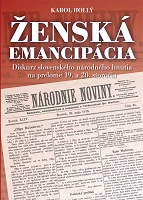Ženská emancipácia. Diskurz slovenského národného hnutia na prelome 19. a 20. storočia
Emancipation of women. The Slovak national movement discourse at the end of 19th and beginning of the 20th century
Author(s): Karol Hollý
Contributor(s): Jozef Hupka (Editor), Peter Macho (Editor)
Subject(s): History, Social Sciences, Gender Studies, Education, Media studies, Sociology, Social history, Modern Age, Recent History (1900 till today), 19th Century
Published by: SAV - Slovenská akadémia vied - Historický ústav SAV
Keywords: Slovakia; Slovak national movement; women; emancipation; 19th century; 20th century; education; media;
Summary/Abstract: Author analyzes the history of women’s emancipation in the discourse of Slovak national movement at the turn of the century. The basic assumption of the publication is that there was a direct relationship between history of women’s emancipation and history of nationalism. Karol Hollý’s observation of this phenomenon is based primarily on history of ideas, which were inevitable for the contemporary nationalist thinking. Main object of the monograph is the ideological concept of Slovak nationalists (Slovak national movement or Slovak women movement) at the turn of the century in the context of women’s emancipation idea. The aim of the book is to define, how the concepts of women and their role in society were constructed in the discourse of the Slovak nationalists. First chapter is dealing with the basic question of the education of women, analyzing both the institutional-legal point of view and the discourse of the Slovak nationalists. The chapter also includes an analysis of the education process of Mária Bellová, a woman with Slovak national identity, who, in the given circumstances, acquired an unusually high level of education. In the second chapter, the author explores the complicated genesis of the first Slovak journal for women (Dennica) and its reception in the circle of Slovak nationalists. Third chapter is devoted to the key question of the Czech and Slovak women movement relations in the context of conflicting national ideologies of independent Slovak nation and national unity of Czechs and Slovaks. Main focus of the fourth chapter is the so called Embroidering movement. The nationalist context of the embroidering is documenting the connection between Slovak women movement and Slovak national movement. Fifth chapter consists of case studies. It is divided into two parts, covering detailed analysis of the discourse in newspapers from 1913 about fundamental questions of women’s emancipation – women suffrage, professional realization of women in the public sphere, social welfare of the unmarried women, freedom to decide not to marry and so on. Themes analyzed in the individual chapters confirm the initial hypothesis, that the question of women’s emancipation was subordinated to the nationalist objectives. It was because of nationalism that women question acquired its prominent role in the national community. Women became responsible for creating the secure background for the men involved in the national movement. The “living space” of women was, therefore, limited to the household, the role of wives and, first of all, mothers, raising and preparing the next generation of nationalists for their future “national tasks”. This function was accepted also in the Slovak women’s movement. According to the author, despite some conflicts between ideas of Slovak national and Slovak women’s movement (observable in the genesis of Dennica), they were, in fact, not in opposition. One of the reasons was the political orientation of Živena (association of Slovak women) and its representatives on the so called Martin centre of Slovak National Party. In comparison with the earlier periods, in the era before WWI, the women question became an increasingly broader concept in the framework of national discourse. The restricted concept of a woman in a household was supplemented with an image of woman active in the public sphere as a valued member of the national community. During this time, the so called woman question was clearly influencing the differentiation among the Slovak nationalists. However, there was a general consensus regarding positive attitude towards the women suffrage. This has to be understood in the context of Slovak nationalism in Kingdom of Hungary – women should have added to the number of the nationally oriented voters. The most fundamental conclusion of the publication is that for the whole analyzed period the nationalism had a priority over feminism; the women question was always secondary to the Slovak question.
- Print-ISBN-13: 978-80-89396-16-0
- Page Count: 178
- Publication Year: 2011
- Language: Slovak
- eBook-PDF
- Table of Content
- Sample-PDF
- Introduction

